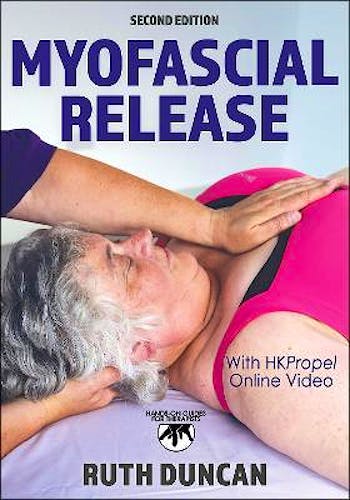

No hay productos en el carrito



Myofascial Release
Duncan, R.
2ª Edición Noviembre 2021
Inglés
Tapa blanda
248 pags
608 gr
18 x 26 x 2 cm
ISBN 9781718200715
Editorial HUMAN KINETICS BOOKS
LIBRO IMPRESO
-5%
54,02 €51,32 €IVA incluido
51,94 €49,35 €IVA no incluido
Recíbelo en un plazo de
2 - 3 semanas
Part I. Getting Started With Myofascial Release
Chapter 1. Introduction to Myofascial Release
- Elements of Fascia
- Conditions That Affect Fascia
- Myofascial Release Concepts
- MFR Versus Other Massage Modalities
- Benefits of MFR
- MFR Treatment Sessions
- Closing Remarks
- Quick Questions
Chapter 2. Initial Assessment
- Client Consultation
- Medical History
- Physical Assessment
- Closing Remarks
- Quick Questions
Chapter 3. Preparation and Communication
- Contraindications
- Equipment and Room Preparation
- Correct Body Mechanics
- Mental Preparation
- Therapist and Client Communication
- Effects of and Responses to MFR
- Closing Remarks
- Quick Questions
Part II. MFR Applications
Chapter 4. Palpatory and Physical Assessments
- Palpatory Assessment
- Tissue Mobility and Glide
- Traction and Compression
- Skin Rolling
- Rebounding
- Closing Remarks
- Quick Questions
Chapter 5. MFR Technique Approaches
- How to Apply Every MFR Technique
- Cross-Hand Releases
- Longitudinal Plane Releases
- Compression Releases
- Transverse Plane Releases
- Scar Tissue and Adhesion Management
- Myofascial Mobilisations
- Combining Techniques
- Closing Remarks
- Quick Questions
Part III. Applying MFR Techniques
Chapter 6. Cross-Hand Release Approaches
- Leg Techniques
- Arm Techniques
- Torso Techniques
- Head and Neck Techniques
- Closing Remarks
- Quick Questions
Chapter 7. Longitudinal Plane Releases
- Supine Pulls
- Prone Pulls
- Bilateral Pulls
- Oppositional and Side-Lying Pulls
- Closing Remarks
- Quick Questions
Chapter 8. Compression Releases
- Soft Tissue Compression Techniques
- Joint Compression Techniques
- Closing Remarks
- Quick Questions
Chapter 9. Transverse Plane Releases
- Pelvic Floor Techniques
- Respiratory Diaphragm Techniques
- Thoracic Inlet Techniques
- Transverse Plane Techniques at Joints
- Closing Remarks
- Quick Questions
Chapter 10. Scar Tissue and Adhesion Management
- Scar Tissue Techniques
- Stacking the Position of Ease Techniques
- Direct Scar Tissue Release Techniques
- Closing Remarks
- Quick Questions
Chapter 11. Myofascial Mobilisation
- Applying Myofascial Mobilization
- Myofascial Mobilization Techniques
- Closing Remarks
- Quick Questions
Part IV. MFR Programs and Management
Chapter 12. Combined Techniques and Taking MFR Further
- Myofascial Position of Ease Techniques
- Combining Techniques
- Closing Remarks
- Quick Questions
Chapter 13. MFR Treatment Approaches
- Individual Treatment Approaches
- Intensive Treatment Approaches
- Multi-Therapist Treatment Approaches
- Home Programmes
- Closing Remarks
- Quick Questions
Answers to Quick Questions
References
Photo Index
Myofascial Release, Second Edition With HKPropel Online Video, offers a dynamic approach to fascial and soft tissue work suitable for all students embarking on a career in hands-on therapy as well as for experienced therapists looking to add skills to their treatments. Ruth Duncan, an advanced myofascial release therapist, proprietor, instructor, lecturer, national committee member and John F. Barnes protégé, shares her expertise to offer in-depth descriptions of myofascial techniques and their applications.
This scientifically grounded approach presents an overview of the entire fascial matrix, the three-dimensional web of tissue that supports every other structure in the body. The explanation of the anatomy and function of the connective tissue system gives practitioners the solid background needed to treat muscle injury, immobility, and pain. The book also outlines how myofascial release relates to other massage modalities, allowing therapists to incorporate a range of treatments.
Descriptions of over 60 myofascial techniques contain details on the timing, direction, and hold of each stretch as well as numerous photographs that illustrate the body and hand positions of each technique. Nuanced explanations of the unique feel of soft tissue help the therapist enhance their palpation skills. The therapist learns how to apply the best approach (cross-hand releases, longitudinal plane releases, compression releases and transverse plane releases) on specific injuries or issues. A new chapter on scar tissue details how practitioners can relieve the pain and tension common in surgical and other types of scars. The text also contains home programs that clients can use themselves between treatment sessions.
Myofascial Release, Second Edition, includes special features that make this resource more effective for readers:
- Full-color photos present a strong visual guide to employing each technique safely.
- The photo index quickly points readers to the desired technique.
- Tips provide practical comments on applying the techniques.
- Client Talk boxes share the author’s experiences and insights on common situations.
- Quick Questions at the end of each chapter test readers’ knowledge of material.
- More than 20 online videos showcase visual demonstrations to help the reader learn the techniques more quickly and accurately.
Finally, the text offers insight on interacting with clients. It covers the client consultation process, how to check for contraindications and perform the visual assessment, how the client may respond to the treatment, and what the practitioner and client might feel and see during the process. Readers will conclude Myofascial Release, Second Edition, with a holistic understanding of the approach and how to apply the principles to their practice.
© 2025 Axón Librería S.L.
2.149.0